According to data from the National Postsecondary Student Aid Study, funded every four years by the National Center for Education Statistics, increasing numbers of students with disabilities are seeking postsecondary educational opportunities. During the 1999–2000 academic year, approximately nine percent of undergraduates self-reported having a disability,1 an increase from six percent in 1995–1996.2
At the same time, prospective students are using the Web in greater numbers to find information about colleges. More than 65 percent of college-bound students reported that using the Web is more valuable than print resources to determine where they would like to go for postsecondary education.3 Although the number of prospective college students is not broken out to show how many have disabilities, a recent study indicated that 85 percent of school-age children with disabilities use computers.4 Jutta Treviranus, director of the Resource Center for Academic Technology at the University of Toronto, estimated that 15 percent of their university population requires some form of adaptive technology (to cope with everything from blindness through print disabilities and ADD/ADHD).5
In December 2000, the federal Architectural and Transportation Barriers Compliance Board (Access Board) issued the "Electronic and Information Technology Accessibility Standards" (36 CFR Part 1194) in response to Section 508 of the Rehabilitation Act Amendments of 1998 (29 U.S.C. 794d). (See Tables 1 and 2 for further information about the standards.6)
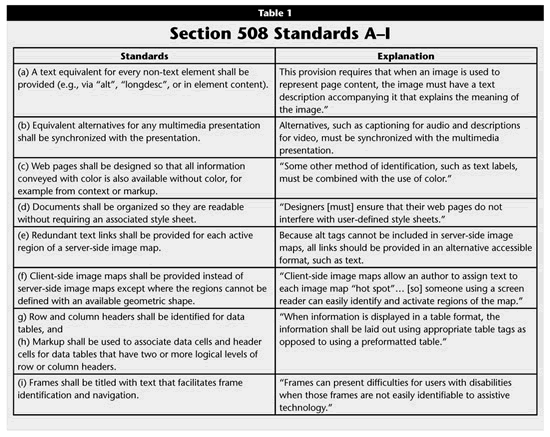
Click image for larger view.
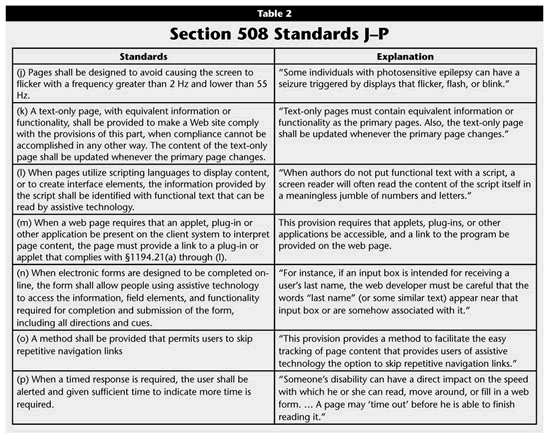
Click image for larger view.
Although Section 508 only applies to agencies of the federal government, the Access Board’s standards are being broadly adopted by many state legislatures. Additionally, when electronic and information technology are not accessible in an academic setting, the standards could be used as the basis for litigation under Section 504 of the Rehabilitation Act, a 1973 law that applies nondiscrimination standards to all entities receiving federal funding (including colleges and universities for such programs as Pell grants and work study funds).
The purpose of this study was to determine what prospective students with disabilities would find if they viewed the Web sites of the top four-year liberal arts colleges in the country. The specific questions asked were whether prospective students with disabilities could access the home page, whether they could find information about services that might be provided to them, and whether they could determine who to contact if they had additional questions.
Method
Between November 2003 and March 2004 we studied the Web sites of the top 50 nationally ranked liberal arts colleges and universities in 2004, according to U.S. News and World Report.7 (Because of a tie for 50th position, the study included 51 institutions; see the sidebar "Colleges Included in the Study" for a full list.) Although there are flaws in any ranking system, the sample for this study was drawn from results of this ranking for three reasons.
First, the U.S. News and World Report ranking is widely recognized both inside and outside of the academic circle. Colleges use their ranking as a marketing tool, and the magazine features the results in an article each year.
Second, it was relatively easy to extract data on liberal arts colleges from this ranking because the magazine uses "Liberal Arts Colleges–Bachelor’s" as one of its categories. The colleges included in this category "focus almost exclusively on undergraduate education."8
The third and most important reason for using this ranking was that the evaluation criteria include figures related to graduation and retention of students; percent of classes under 20 students; percent of classes with 50 or more students; and student-to-faculty ratio. These are all criteria that would be meaningful for a student who might need special attention, particularly students with learning disabilities.9 Twenty-nine of the 51 schools included in this study reported the number of students using disability services on their campus. The portion of students using these services ranged from less than 1 percent to almost 11 percent of the student body.10
We took various steps to determine how open the colleges might appear to prospective students with disabilities. For each site, we first checked the home page to determine whether it had been designed to meet accessibility guidelines for people with disabilities. Then, links on the home page were viewed to determine whether information about services for students with disabilities was readily available. We also conducted a search using the site’s search engine. Although information may have been missed, this study allotted 30 minutes per college to locate information about disability services. As information professionals using a high-speed Internet connection, the research team determined that the amount of time allotted was generous, considering the comparatively limited resources that might be available to prospective students.
Methodology and Results
Data from this study indicate that in general the needs of students with disabilities do not appear to be considered in the design of Web pages or the organization of content. The majority of the home pages included in the study were not developed with accessibility standards in mind, and information about disability services was difficult or impossible to locate from several of the Web sites.
Home Page Accessibility
The home pages of the 51 colleges were checked using Bobby, "a comprehensive Web accessibility software tool designed to help expose and repair barriers to accessibility and encourage compliance with existing accessibility guidelines,"11 and with JAWS. JAWS is a well-known and widely used screen reader or voice-output program used by people with visual impairments, motor difficulties that limit their ability to turn pages, and/or cognitive disabilities that necessitate reading assistance.
Bobby is an accepted standard in creating accessible Web sites. It checks Web sites for errors in compliance with various Web accessibility guidelines. Bobby uses logarithms to automatically check certain aspects of Web sites, such as the presence of alt tags (textual descriptions of images that cannot be seen by people with visual impairments). Some accessibility issues cannot be evaluated in this manner, however, and must be manually checked.
The sites in our study were checked using Bobby’s Priority 1 or A level. Although this level is the lowest standard of accessibility, these checks meet or exceed compliance with the Section 508 standards of the Rehabilitation Act. The examination of these Web pages for accessibility was done in a three-step process.
Of the 51 home pages examined, only three schools passed the Bobby accessibility test. Most of the other colleges could meet the accessibility guidelines with minor revisions of their Web pages. Some, however, would need a complete redesign to meet the needs of many people with disabilities.
One method used to make Web sites accessible is to provide a text-only version. This approach is recommended only when there is no other way to present the information. Provision 1194(k) of Section 508 states that if this method is used, "the content of the text-only page shall be updated whenever the primary page changes."12 Four schools in our study had accessible text-only versions of their home pages. Only two of these four text-only versions, however, contained all the information available on the graphical page. The content that was lost in the other two pertained to current events and news. The graphical home page of one of the two schools with a complete text-only version did meet the Bobby accessibility requirements, so the text-only page was not necessary to meet the needs of students with disabilities.
A few consistent problems existed across the majority of home pages. In a census report on disability, 7.7 million people over the age of 15 reported difficulty seeing words and letters in ordinary newsprint, even with glasses or contact lenses.13 A person who has difficulty seeing newsprint might have even more difficulty reading some Web pages because home pages often shrink the font size in order to keep all of the text on one screen. If the font size is smaller than 10 points, it will likely be difficult for many people to read. Microsoft Internet Explorer, which was used when viewing and checking these home pages, has a feature that allows the user to increase the size of the text. This feature does not work, however, if the text on the page is set to a non-resizable font or is a part of an image.
Of the home pages in the study, 36 did not have measures in place to allow users to increase the text size. Most of these problems occurred because the text was placed in image boxes. Users cannot resize images to accommodate visual impairments without the use of special screen magnification software such as MAGic or ZoomText.
Internet Explorer does provide an option to turn off the font sizes specified by the Web page so that a user can resize the text. This is accomplished by turning off the style sheets so that the user can use a personal style sheet as mentioned in provision 1194.22(d) of Section 508. The problem is that the Web page has often been set up in tables or boxes with a specified height and width that does not resize with the font; therefore, the text no longer fits in the table or box, and pieces of text are cut off when enlarged. Twelve of the 51 home pages had text-resizing problems when this feature was used to turn off the specifications.
Another consistent problem we encountered concerned alt tags. Alt tags are the little boxes that show up when the cursor is over an image to tell what is contained in the image. (See Figure 1 for an example of an alt tag.) These tags are required by provision 1194.22(a) of Section 508. Alt tags can be read by a screen reader so that the user knows what is in the image. Within this study, 35 of the 51 home pages were missing alt tag labels, and an additional 9 schools had insufficient alt tags. This means that 44 colleges, or approximately 86 percent of the schools, did not meet the accessibility guidelines for alt tags. One example of an insufficient alt tag was an image of a student leaning against a tree while studying with an alt tag stating "campus images." This description tells nothing about the image, and it will not provide a mental picture for the user of a screen reader.
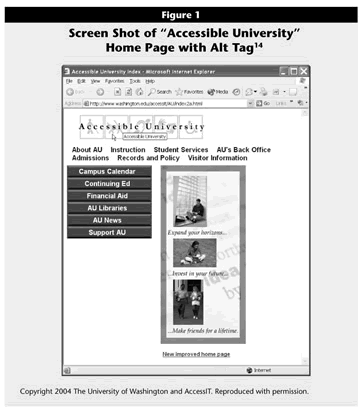
Click image for larger view.
The accessibility features discussed thus far have focused on the needs of people with visual difficulties using the Web page. The next issue is for a person with navigation difficulties. In the study, 18 of the 51 colleges used mouse-over boxes, and 12 additional colleges used dropdown boxes. Mouse-over boxes are lists of related links that appear when the cursor is placed over the initial heading link, such as Academics and Admissions (see Figure 2 for an example of a mouse-over box). Dropdown boxes are text menus that appear on a click of the mouse. These are often seen as Quick Links boxes on college home pages. These features are only accessible by mouse users, and a 2001 census report states that 6.8 million Americans have difficulty using their hands.15 If users hit the right combination of keys, they can access the text in a dropdown box using the screen reader; however, at this time, mouse-over boxes are inaccessible.
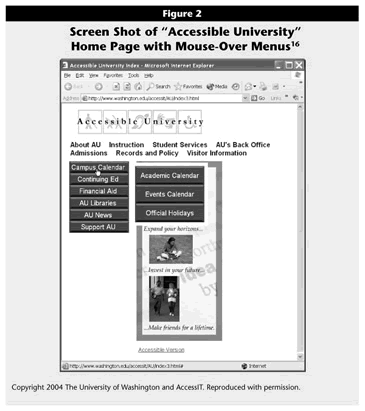
Click image for larger view.
This study found Flash, the most inaccessible feature of any of the Web sites, on two college home pages. Flash allows for splashier Web sites but is unreadable by screen readers and requires additional software to view. Schools also tend to use changing graphics and text when they use Flash; therefore, a user who has a cognitive disability may have difficulty reading the screen before it changes. Images that scroll across the top of the screen may be nice in that they show different images from the school, but they are inaccessible to the screen reader user and may go too fast for others.
Table 3 summarizes the data related to the accessibility issues found on the home pages of the colleges studied.
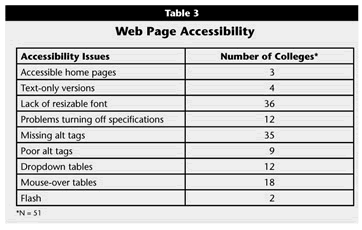
Click image for larger view.
Locating Disability Services
The second step in this study was to determine whether prospective students could locate information about the types of disability services offered by the colleges. The following two-step process was employed to search for the information:
Anticipating that students or their families might have additional questions, we also sought information about a designated contact person (name, telephone number, or e-mail address).
One way people try to locate information on a Web page is by starting with the home page and following the links. Most of the college home pages were dense with information about the school. Overall page layout or the dropdown menus on over half of the sites provided links to a variety of offices, services, and programs and often included specific links for international students, minority students, and/or honor students. Services for students with disabilities, however, was a direct link from the home pages of only two of the 51 colleges included in the study. Although this provides the quickest access to the information, one of the colleges used a mouse-over table and the other a dropdown table; therefore, neither school listed the information about disability services in an accessible format.
Because most of the colleges did not have direct links to disability services, the next step was to try to identify a link from the home page that would lead to information about disability services. By doing this, we located information about disability services for 23 of the schools in the study, but most of the information was found on pages that were at least three layers removed from the home page.
A common problem was trying to determine where to begin looking for the desired information. Although home pages were unique in their design, most shared a common set of links. Links to academics, administration, and student life were found on most home pages, and we eventually found information about disability services by following one of these—but not always the same one—for most of the Web sites we evaluated. This appeared to be due in part to the varying organizational structures of the colleges in the study and the placement of information about disability services within that structure. Only one college provided a similar path of links to disability services from each of the three headings (academics, administration, and student life) to increase access.
Another way people try to locate information is by using the Web site’s search engine. For 25 of the 51 schools in the study, information about disability services was provided as an obvious link near the top of a list of search results. The links were clear from the label used on the list or by short descriptions that accompanied them, and they appeared on the first two pages of search results. The latter criteria was incorporated into the study because searches often resulted in more than 100 results listed on multiple pages and included information unrelated to the study, such as human resources information and research papers related to disability. For an additional eight colleges, the search results yielded an indirect link to disability services by having the user locate the information through a link from another site. This would take the searcher two or more links away from the results page to find the appropriate information.
We sought two types of information from the college Web sites: a description of the services provided, and contact information for additional questions. When information was found, most colleges provided both types of information; however, seven colleges provided only information about their services, and four schools listed only contact information. For 10 of the schools in the study, we were unable to locate contact information or information about disability services. The search results from one college, for example, were all labeled "Event Detail" followed by URLs that gave no hints to the information included.
One of the schools where no information could be located was one of the three colleges in the study that was found to have an accessible home page. Information was provided within the Web sites of the other two schools with accessible pages; however, contact information could not be located for one of the two.
Only three college home pages in our study met accessibility standards, while two others provided a direct link from the home page to disability services; these two groups did not overlap.
Conclusions and Recommendations
Although the number of undergraduate students with disabilities is growing, as shown by the National Postsecondary Student Aid Study, the results of this study indicate either a lack of knowledge of accessibility standards or a concern that a redesign would be too difficult, costly, and time consuming. The Office of Civil Rights (OCR) in the U.S. Department of Education addressed the ability of students to use the Internet in pursuit of their education in California. Between 1994 and 1999, the OCR in Region IX undertook eight investigations of colleges in the California Community College system. These cases dealt with the provision of effective communication and equal access. The primary focus was on provision of class materials through the library, campus, publications, and the Internet. The OCR stated that "OCR has repeatedly held that the term ‘communication’ in this context means the transfer of information, including (but not limited to) the verbal presentation of a lecturer, the printed text of a book, and the resources on the Internet."17 Because Web pages are "communications" in college education, complaints can be filed with the OCR under Section 504.
The California Community Colleges have developed a voluntary plan to deal with Web accessibility issues. This plan includes following Section 508 standards and has resulted in the creation of the "High Tech Center Training Unit," which provides training and support to the 114 community colleges and satellite centers in California.18 While the OCR’s decisions in regard to California were made on a regional level, the National Council on Disability stated that "their impact has been national in scope."19
To begin to understand the potential for an OCR complaint, colleges could identify Web accessibility errors. Several tools, such as Bobby, Cynthia Says, and A-Prompt, are available to assist with this process. These programs will also provide prompts to additional features that will need manual checks, such as ensuring that color is not used to represent specific information (1194.22(c)). Once the problems are identified, colleges should develop programs and policies to effectively implement an accessible Web site.
Colleges should follow a six-step process to provide accessible pages on their Web sites:
Having a plan in place, with evidence of progress toward increased accessibility, has been shown to minimize the impact of an OCR complaint. The Ohio State University (OSU) has developed a model policy and plan.20 The OSU Web Accessibility Policy includes purpose and scope statements, a policy with specific standards and implementation priorities, and methods for reporting and reviewing progress. One feature of the implementation priorities is that they clearly state that new and revised pages must be accessible, and the plan sets a goal of converting the top 15 percent of pages each year. The priorities appear to be reasonable and easily adopted by any institution.
A few specific areas of concern arose from our study and need consideration. One of these areas is the use of image boxes with text inside. If text is represented in an image, a screen reader will simply read this as an image unless there is an alt tag with the text. A solution to this problem is to only present text outside of images. Even if an image does not contain text, it still needs a detailed alt tag to describe the graphical content.
Although the mouse-over table design gives the user access to a greater number of direct links, current technology does not support mouse-over use by people who use screen readers and often causes difficulties for people with dexterity impairments and difficulty with small print. Dropdown menus can be accessed with screen readers if the right combination of key strokes is used; however, they present the same problems for individuals with impaired dexterity and restricted vision.
The overall design of a Web page should focus on the ability of all students—with and without disabilities—to navigate its structure. Most prospective students have a limited understanding of the hierarchy of the campus; therefore the Web site should include the use of links to disability services from multiple paths, such as academics, administration, and student life. Although this study focused on one area of possible problems, Web developers from these units should collaborate to ensure that prospective students can access needed information from all departments with relative ease.
When it is difficult to coordinate the structure of an institution’s Web pages, search engines—placed in a highly visible location on the site—should be powerful enough to find needed information while filtering out extraneous materials. Web page designers should also be trained in the appropriate use of keywords to assist in the location of information. In the area of disability services, that would mean using the word "disability" in the meta content, not phrases like "learning different."
Disability services personnel often need advanced notice of student needs to make the necessary accommodations (for example, hiring sign-language interpreters, acquiring specific adaptive technology software, and converting print to digital formats). When students are unaware of available services or whom to contact, it is difficult to give adequate notice. Many incoming students with disabilities are thus further handicapped in their pursuit of an education while the needed arrangements are made. Web designers should ensure that adequate information is on the Web site to ease new students’ transition into the higher education environment.
After all accessibility standards have been met, designers will recognize that they no longer need to maintain both graphic and text-based Web sites. This will reduce the possibility of having outdated or incomplete information on the text-based page, as found in this study.
As more students with disabilities begin postsecondary education, the need for access to information will increase. The accessibility standards provide a blueprint to maximize access and minimize the potential for legal action against colleges. Although the needed modifications raised in this study may appear overwhelming, Rachel Reuben, Web Coordinator at State University of New York, stated, "[Web developers’] fears of having to change their entire sites were quickly relieved when they learned what small changes they would have to make, mostly in the background (HTML code)."21
Finally, further research is needed in two specific areas to better understand this phenomenon. A broader sample needs to be used to determine whether the issues present are just those of the colleges in the study or are prevalent across higher education. Specifically, would the results be the same for large, state-funded universities? Of greater importance would be the inclusion of people with disabilities in the research process. Web developers should include prospective and current students with disabilities in usability studies to determine whether the Web sites are accessible and the information they need is available.
